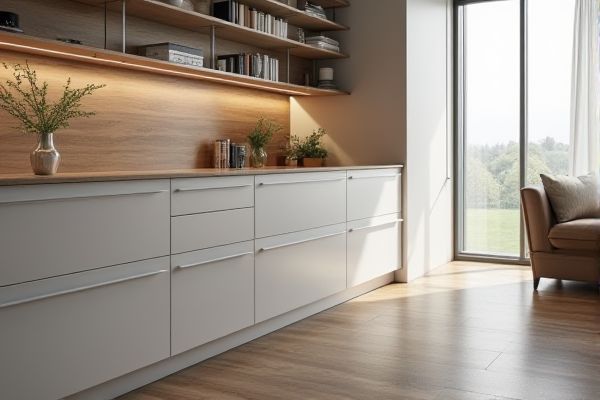
Plinth drawers maximize under-cabinet storage by utilizing the often wasted space at the base of your cabinets, providing easy access to stored items without compromising kitchen design. Explore the rest of the article to discover which option best suits your kitchen layout and storage needs.
Table of Comparison
| Feature | Plinth Drawers | Base Cabinets |
|---|---|---|
| Location | Installed in kickspace (plinth) area beneath cabinets | Standard cabinet units installed above the floor level |
| Storage Capacity | Limited, ideal for flat or small items | Large, accommodates bulky and heavy items |
| Accessibility | Easy access but low to the ground | Ergonomic, at waist or knee height |
| Installation | Requires precise fitting into plinth area | Standard installation with countertop support |
| Cost | Generally lower cost due to smaller size | Higher cost related to volume and complexity |
| Common Use | Storage of baking trays, cutting boards, slim tools | Storage of cookware, utensils, large appliances |
| Customization | Limited customization options | Highly customizable with shelves, drawers, organizers |
| Material | Typically wood or MDF matching cabinetry | Varied materials including wood, MDF, metal |
Introduction to Plinth Drawers and Base Cabinets
Plinth drawers are storage compartments integrated into the recessed base, or plinth, of kitchen cabinets, maximizing otherwise unused space while maintaining a sleek design. Base cabinets provide essential foundational support for countertops and appliances, featuring accessible storage options like shelves and drawers above the plinth. Understanding the structural roles and storage possibilities of plinth drawers versus base cabinets is key to optimizing kitchen layout and functionality.
Defining Plinth Drawers: Features and Uses
Plinth drawers, also known as toe-kick drawers, are built into the recessed space beneath base cabinets, providing hidden storage without occupying standard cabinet volume. These drawers capitalize on otherwise unused floor-level space, offering ideal storage for flat or infrequently accessed items like baking sheets, trays, and cleaning supplies. Their discreet design enhances kitchen organization and maximizes space efficiency compared to traditional base cabinets.
Understanding Base Cabinets: Structure and Functionality
Base cabinets serve as the foundational storage units in kitchens, offering sturdy support for countertops and housing essential drawers or shelves for organization. Unlike plinth drawers, which are designed to utilize the toe-kick space beneath cabinets, base cabinets provide full-depth storage, optimizing your kitchen's functionality. Their robust structure ensures durability and efficient use of space, making them crucial for effective kitchen design.
Storage Capacity: Plinth Drawers vs Base Cabinets
Base cabinets offer significantly larger storage capacity compared to plinth drawers, accommodating bulkier kitchen items such as pots, pans, and small appliances. Plinth drawers, integrated into the toe kick area beneath base cabinets, provide shallow but convenient storage space ideal for flat or rarely used items, maximizing underutilized space. For optimal kitchen organization, combining both allows effective use of deep storage in base cabinets with accessible, space-saving compartments in plinth drawers.
Space Optimization in Modern Kitchens
Plinth drawers maximize under-cabinet space by utilizing the typically wasted toe-kick area, offering discreet storage ideal for small kitchen tools and cleaning supplies. Base cabinets provide larger, more accessible storage for pots, pans, and bulkier kitchen items, facilitating organization in primary cooking zones. Combining plinth drawers with base cabinets enhances overall kitchen space optimization, creating efficient storage solutions tailored to modern kitchen layouts.
Aesthetic Considerations: Design and Visual Impact
Plinth drawers create a sleek, seamless look by integrating storage within the baseboard area, enhancing minimalistic and modern kitchen designs. Base cabinets offer a traditional visual profile with visible doors and hardware, providing more design versatility through styles, colors, and finishes. Your choice between the two will significantly affect the overall aesthetic impact, either emphasizing streamlined simplicity or classic cabinetry appeal.
Installation and Accessibility Differences
Plinth drawers offer a discreet, space-saving storage solution installed directly into the baseboard area, making installation less intrusive but maintaining accessibility at a lower height. Base cabinets require more extensive installation, involving fitting and aligning the entire unit to the wall and countertop, but provide easier access to stored items at waist level. Your choice depends on whether you prioritize minimalist installation with subtle accessibility or more conventional, ergonomic reach and storage capacity.
Durability and Maintenance Comparison
Plinth drawers offer enhanced durability due to their robust construction and resistance to wear at the base level, making them less prone to damage from moisture and impacts compared to standard base cabinets. Maintenance for plinth drawers is generally easier as their components are often designed for smooth operation and simple access, reducing the risk of dirt accumulation and mechanical failure. Base cabinets, while versatile, may require more frequent upkeep and repairs, especially in high-traffic kitchen areas where spills and heavy use can degrade materials faster.
Cost Analysis: Plinth Drawers vs Base Cabinets
Plinth drawers typically offer a cost-effective storage solution compared to base cabinets due to their smaller size and simpler installation requirements. Base cabinets generally involve higher material and labor costs, as they provide more comprehensive storage with doors and internal shelving. Evaluating your kitchen layout and storage needs will help determine if the budget-friendly plinth drawers or the more versatile base cabinets provide better value for your investment.
Choosing the Best Option for Your Kitchen
Plinth drawers maximize under-cabinet storage by utilizing the toe-kick space, ideal for kitchens with limited room or a minimalist aesthetic. Base cabinets offer versatile storage with adjustable shelves, accommodating larger items and customizable interiors to suit varied kitchen needs. Consider your kitchen layout, storage requirements, and accessibility preferences when selecting between plinth drawers and base cabinets to optimize functionality and space efficiency.
 homyna.com
homyna.com